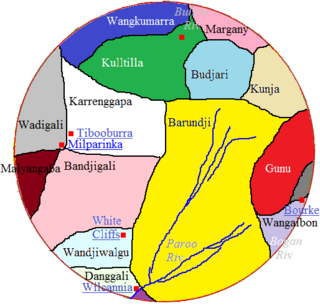History
A very late tradition collected in 1979 states that a certain Jimmy Reid, A Camboon station resident, told a third party before his own death, that the Wulili had participated in the Hornet Bank massacre. In her memoir, the Queensland poet Judith Wright affirmed that, together with the Yiman, who were held responsible for the killings of the Fraser family, the Wulili also were wiped out. John Mathew, however, managed to collect samples of their language from native informants decades later, and published the results in 1926.
The Hornet Bank massacre of eleven British colonists and one Aboriginal station-hand in direct retaliation to the deaths of twelve Iman people by member(s) of the Fraser clan, occurred at about one or two o'clock on the morning of 27 October 1857. It took place at Hornet Bank station on the upper Dawson River near Eurombah in central Queensland, Australia. In subsequent punitive missions conducted by Native Police, private settler militias and by William Fraser, as many as 300 Aborigines may have been murdered in counter-retaliation. Indiscriminate shootings of Aboriginal men, women and children found within a wide radius of the station were conducted. The result was the believed extermination of the entire Iman tribe and language group by 1858, but this is however not true and descendants of this group have recently been recognised by The High Court of Australia to be the original custodians of the land surrounding the town of Taroom.

Judith Arundell Wright was an Australian poet, environmentalist and campaigner for Aboriginal land rights. She was a recipient of the Christopher Brennan Award.
The Yiman, also referred to as Yeeman/Eoman or Jiman, and by themselves in modern times as Iman, are an Indigenous Australian tribe living in the Upper Dawson River region around Taroom of eastern Central Queensland.
This page is based on this
Wikipedia article Text is available under the
CC BY-SA 4.0 license; additional terms may apply.
Images, videos and audio are available under their respective licenses.
The Bakanambia, also known as the Wanbara, are an Aboriginal group of Australia. Traditionally, the Bakanambia lived in the vicinity of Princess Charlotte Bay in the state of Queensland. One of the ethnonyms applied to them was Lama Lama, which is now used of a larger aggregation of remnants of several tribes.

The Gubbi Gubbi, also written Kabi Kabi, people are an Indigenous Australian people native to southeastern Queensland. They are now classified as one of several Murri language groups in Queensland.

The Kangulu, also written Gangulu, is an aboriginal tribe from the Mount Morgan area in Queensland, Australia.
The Wakka Wakka are an indigenous Australian people of the state of Queensland.
The Waanyi people are an Indigenous Australian people south of the Gulf of Carpentaria in Queensland and the Northern Territory.
The Nyawaygi, also spelled Nyawigi or Nawagi, are an Indigenous Australian peoples whose original country was Halifax Bay, North Queensland
Mbabaram or Mbabaram, often referred to as the Barbaram people, are an Indigenous Australian people living in Queensland on the rainforests of the Atherton Tableland.
The Anēwan, also written Anaiwan/Anaywan, are the traditional owners of the land around Armidale and the New England tableland in New South Wales.
The Bidia, also called Biria, are an indigenous Australian people of the state of Queensland. They are not to be confused with the Biria, the tribe on the Bowen River.
The Mbewum were an indigenous Australian people of the Cape York Peninsula of northern Queensland. They were dispossessed and became extinct soon after colonization.

The Karenggapa are an indigenous people of New South Wales. They might have spoken a dialect of the Yarli language, but there is little data.
The Punthamara were an indigenous Australian people of the state of Queensland.
The Galali or Kalali were an indigenous Australian people of the state of Queensland.
The Julaolinja were an indigenous Australian people of the state of Queensland.
The Madjandji, also known as the Majañji, are an indigenous Australian people in the area south of Cairns in the state of Queensland.
The Marulta were an indigenous Australian people of the state of Queensland.
The Biyaygiri, also known as Bandjin, were an indigenous Australian people of northern Queensland.
The Nggamadi were an indigenous Australian people of the Cape York Peninsula of northern Queensland.
The Kokomini (Gugumini) are reported to have been an indigenous Australian people of the state of Queensland, though some indications suggest the term may refer to a loose confederation of tribal groups.









